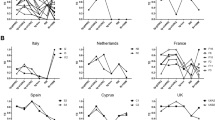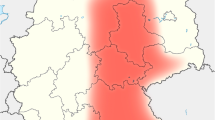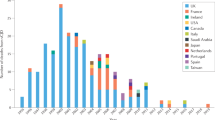Epidemiological analysis helps in evaluating the potential risks of eating French beef.
Abstract
The United Kingdom has reported the largest number of cases so far of bovine spongiform encephalopathy (177,490 animals), but native-born cases have been reported in other European countries as well (Republic of Ireland, 524; Portugal, 447; Switzerland, 350; France, 143; Belgium, Denmark, Germany, Liechtenstein, Luxembourg, the Netherlands and Spain, each fewer than 20 cases)1. Here I analyse BSE-incidence data2 from France ( Fig. 1a) to estimate the size and course of the epidemic there and find that at least 1,200 French cattle have been infected with the aetiological agent that causes BSE since mid-1987. This suggests that, even under the most optimistic assumptions regarding the incidence of BSE infection in France, an estimated 49 infected animals will have been slaughtered for human consumption in France during 2000.

a, BSE case incidence by year of clinical onset (confirmed and reported by 17 November 2000; data include only French-born cattle). b, Estimated BSE infection incidence by cohort (with 95% confidence intervals) allowing for under-reporting (red) and assuming complete reporting (blue). Annual birth cohorts were defined so that, for example, the 1992 cohort consists of cattle born between 1 July 1991 and 30 June 1992. The age-specific incidence of BSE was modelled by birth cohort, denoted I(a,c) for age a years and birth cohort c, as I(a,c) = Δ(a+c) S( a)N(c)f( a), where under-reporting is modelled as a time-dependent probability that a BSE case is reported, Δ(a+c) = exp(α+β(99 − a − c))/[1 + exp(α + β(99 − a − c))] for a + c = 99 and Δ(a + c) = 1 for a + c = 100 (ref. 2). S(a) is the probability that an animal survives to age a, N(c) is the number of animals in cohort c infected with the aetiological agent of BSE, and f(a) is the probability (assuming all animals survive to age 18 yr) that an infected animal will experience clinical onset at age a. The parameters α and β were estimated using maximum likelihood assuming that the age-specific incidence of BSE by birth-cohort data arose from a Poisson distribution. The age-at-onset distribution, f(a), (the convolution of the age-at-infection and incubation-period distributions) and the survival distribution, S( a), were taken from validated parameter estimates obtained from back- calculation analysis of the British BSE epidemic4,5,6,7 and survival distribution of British cattle4,7. In a parallel set of analyses, the observed incidence in the last age category for each cohort (I(a,c) for a + c = 100) was boosted by 21% (estimated from the change in I(a ,c) for a + c = 99 between November 1999 and November 2000) to adjust for confirmation delay, as well as for the onset of clinical cases that have yet to occur because, for example, animals in the 1994 cohort could experience clinical onset at age 6 yr in early 2001. As a result of this correction factor, total infections and the number of infected animals slaughtered in 2000 were roughly 19% greater if allowance was made for under-reporting (and 13% greater assuming complete reporting).
This is a preview of subscription content, access via your institution
Access options
Subscribe to this journal
Receive 51 print issues and online access
$199.00 per year
only $3.90 per issue
Buy this article
- Purchase on Springer Link
- Instant access to full article PDF
Prices may be subject to local taxes which are calculated during checkout
Similar content being viewed by others
References
Office International des Epizooties. http://www.oie.int/eng/info/en_esbmonde.htm (as of 1 December 2000).
French Ministry of Agriculture and Fisheries. http://www.agriculture.gouv.fr/alim/sant/mala/cell-testESB/Esb/1-1711.pdf (as of 1 December 2000).
Donnelly, C. A., Santos, R., Ramos, M., Galo, A. & Simas, J. P. J. Epidemiol. Biostat. 4, 277– 283 (1999).
Anderson, R. M. et al. Nature 382, 779–788 (1996).
Donnelly, C. A., Ghani, A. C., Ferguson, N. M. & Anderson, R. M. Nature 389, 903 (1997).
Ferguson, N. M., Donnelly, C. A., Woolhouse, M. E. J. & Anderson, R. M. Phil. Trans. R. Soc. Lond. B 352, 803– 838 (1997).
Donnelly, C. A. & Ferguson, N. M. Statistical Aspects of BSE and vCJD: Models for Epidemics (Chapman & Hall/CRC, London, 1999).
Doherr, M. G., Heim, D., Vandevelde, M. & Fatzer, R. Vet. Rec. 145, 155–160 (1999).
Butler, D. Nature 382, 5 (1996).
Schreuder, B. E. C., Wilesmith, J. W., Ryan, J. B. M. & Straub, O. C. Vet. Rec. 141, 187–190 ( 1997).
Summary of the Spongiform Encephalopathy Advisory Committee Meeting on 29 November 1999; News Release, 22 December 1999 .
Author information
Authors and Affiliations
Corresponding author
Rights and permissions
About this article
Cite this article
Donnelly, C. Likely size of the French BSE epidemic. Nature 408, 787–788 (2000). https://doi.org/10.1038/35048666
Issue Date:
DOI: https://doi.org/10.1038/35048666
This article is cited by
-
Testing times for BSE
Nature (2001)
-
Counting les vaches folles
Nature (2000)
Comments
By submitting a comment you agree to abide by our Terms and Community Guidelines. If you find something abusive or that does not comply with our terms or guidelines please flag it as inappropriate.



